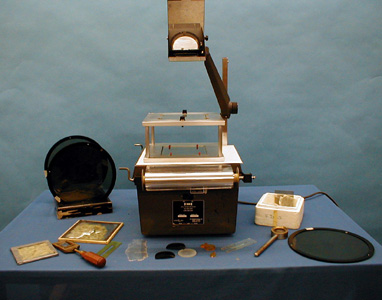Demos: 7B-22 Polarizer Effects

A variety of materials is viewed through crossed polarizers, including quarter-wave plates, stressed materials and others.
Directions: This demonstration can be carried out as far as you like. First dim the room lights. To begin with, take two large polarizers and place one at a time on the overhead to show that nothing unusual happens except that the light is diminished in intensity. Then place one on top of the other, being careful that the axes are lined up. (There should be an identifying mark on the polarizer. If not, test them before hand.) Slowly rotate the top polarizer (which is now the “analyzer”) to show complete darkening. In the supply box are a number of broken clip-on Polaroid sunglasses. You can show that these behave in the same way.
Certain materials have the ability to “rotate” the plane of polarization, but this effect is wavelength dependent. Between two crossed polarizers place the “sandwich” of mica sheets. It will show various colors. If you slowly rotate the analyzer, the colors will change.
Certain materials, when stressed, also are active rotators. Take a piece of plastic bag or plastic wrap and stretch a portion of it almost to the ripping point. Place this portion between the polarizers. It will show one or more colors.
A few plastic pieces in the box are shaped like different objects. When these are placed between the polarizers and squeezed, an array of colors appears at the stress points. Especially beautiful is the pattern observed using an ordinary plastic protractor. The stress points are clearly visible, especially at the center hole.
You can also show the rotational effects of a liquid like Karo syrup. Place a polarizer on the overhead and on top of it the tall glass container (which has a side spout for pouring in the syrup). Then on top of the container place another polarizer at 90 degrees. Adjust the focus and begin pouring in the syrup. As the thickness (depth) of the syrup increases, the colors change.
Suggestions for Presentation: Refer to the frame model Demo 7B - 21 and indicate that the polarizing material is a kind of “molecular picket fence.” When randomly polarized (ordinary) white light passes through the polarizer it is plane polarized along the direction of the axis. The second polarizer (the analyzer) can block this light by turning the axis 90 degrees. Then suggest that if a material could rotate the plane of polarization by 90 degrees before it entered the analyzer, the light would not be blocked. Since this is wavelength dependent, only certain colors will be passed, depending on the thickness.
If you can acquire enough small pieces of polarizing material to hand out to the class, you can also demonstrate how polarizers reduce glare. Light reflected from the surface of non-conductors near the Brewster angle (roughly 50 degrees or so) is plane polarized parallel to the surface. Polarizers can eliminate this light (called “glare.”) Have the students look at reflections on the tile floor or on the desk tops and rotate the polarizers to reduce or eliminate the glare. Point out that Polaroid sunglasses have their axes vertical since most reflections, especially when driving, are from horizontal surfaces.
Applications: Stress analyzers in industry, polarizing sunglasses, camera filters
Last Updated: Nov 30, 2023 11:25 AM